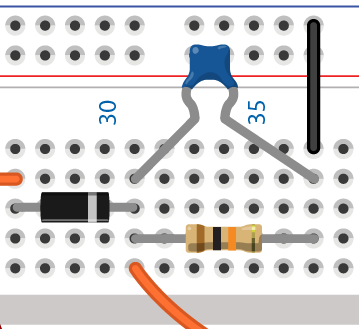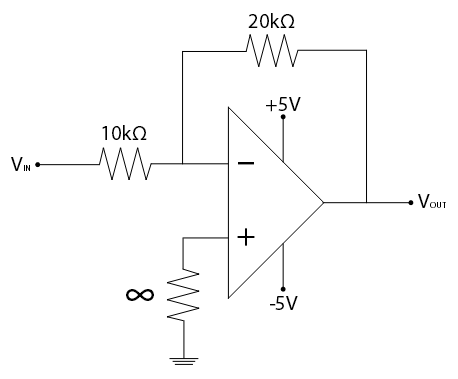Electronics Explorer - Soda Can Theremin
- Constructing a theremin with a soda can antenna and the Analog Parts Kit.
Introduction
Remember those old-school sci-fi movies with squeaky and eerie background music? Those unique sounds were made using a theremin, an electronic instrument that can be played without physical contact. When playing a theremin, the operator can control volume and pitch with his or her hand position relative to two antennas.
This project is going to demonstrate how to build a simple theremin on the Electronics Explorer Board using a soda can as the antenna! With simplicity in mind, the theremin in this project will only demonstrate pitch modulation. The design that is implemented is shown in the block diagram below. It doesn't take too much extra work to add volume control, so I encourage you to try it if you're looking for an extra challenge.
To keep it short and sweet we won't get too deep into the theory of how a theremin works. Briefly though, the antenna (the soda can) acts as one plate of a capacitor. Your hand will act as the other plate of the capacitor. Thus, by moving your hand nearer and further from the can, you are changing the capacitance of the circuit. This takes place within the variable-frequency oscillator portion of our circuit. As the capacitance in the oscillator changes, the oscillator's output frequency changes as well. This change in frequency can be heard at the speaker at the end of the circuit.
Materials
- Electronics Explorer Board w/ Power Supply and USB cable
- From the Analog Parts Kit:
- OP27 Operational Amplifier (x2)
- OP37 Operationial Amplifier
- Small Speaker
- 100pF Ceramic Capacitor
- 0.047uF Ceramic Capacitor
- Small-signal Diode (1N3064)
- 10kΩ resistor (x2)
- 20kΩ resistor (x2)
- 47kΩ resistor (x2)
- 100kΩ resistor (x3)
- Breadboard pins
- Jumper Wires
- Soda can
- WaveForms Software ( download)
Procedures
The circuit will be built all on the same breadboard, one part at a time. It is best to start towards one side of your breadboard and working towards the right to make sure it all fits. An image showing the whole circuit put together is shown in Step 5. You may want to check that image to get an idea of how everything will fit.
Step 1 - Oscillators
For the variable-frequency oscillator, we will be using the OP27 operational amplifier. The pin out and specifications of the OP27 can be seen in the data sheet.
- Place the op-amp such that it straddles the valley of the breadboard and the notch is towards the top of the breadboard.
- Op-amps require +5V at one rail and -5V at the other rail. That being said, one power rail of the breadboard is designated for +5V and the other power rail is designated for -5V. In the breadboard image below, red wires are used for connections to the +5V power rail and white wires are used for connections to the -5V power rail.
- Connect pin 7 of the op-amp to the positive power rail (+5V).
- Connect pin 4 of the op-amp to the negative power rail (-5V).
- Connect a black wire between the ground rail and one of the breadboard rows above the op-amp.
- Place the 100pF capacitor between the grounded row of the breadboard and pin 2 of the op-amp.
- Now we'll place the resistors. All the resistors used in the oscillator are 100kΩ.
- Place one resistor across the op-amp from pin 2 to pin 6.
- Place another resistor across the op-amp from pin 3 to pin 6.
- Place the last resistor between the grounded row of the breadboard and pin 3 of the op-amp.
- The soda can is to be placed in parallel with the capacitor.
- Connect one end of a green jumper wire to pin 2 of the op-amp. You will hold the other end of this wire in your right hand when operating the theremin.
- Connect one end of another black jumper wire (not pictured) to the grounded rail of the breadboard. Connect the other end of this wire to the soda can. A slightly longer jumper wire is easier here. I place the wire such that it is held on by the tab on the top of the can. Taping the wire to the can would work as well. Just make sure there is metal-to-metal contact.
- By holding the green wire in your right hand, your body is now part of the circuit. This allows you to use your left hand to act as a plate of a capacitor with the soda can.
- Connect an orange wire to pin 6 of the op-amp. This will carry the output voltage from this oscillator to the next section of the circuit, the weighted summer.
To save space on our breadboard, we will use the EE Board's Arbitrary Waveform Generator (in the WaveForms Software) to act as the fixed oscillator. On the EE Board (in the breadboard image of step 2), this is the yellow wire. Use WaveForms to apply a sinusoidal wave here. You want the sinusoidal wave to have a frequency close to that of the variable-frequency oscillator. In this project, that is about 25.5 kHz.
Step 2 - Weighted Summer
This next portion of the circuit, the weighted summer, mixes the signals from our fixed and variable-frequency oscillators. We will be using another OP27.
- Move a few holes down the breadboard from the oscillator and place the OP27 such that it straddles the valley of the board and the notched side is towards the top of the board.
- Just as we did when building the oscillator, connect pin 7 of the op-amp to the positive power rail and pin 4 of the op-amp to the negative power rail.
- Connect pin 3 of the op-amp to one of the ground rails on the breadboard.
- Connect two 47kΩ resistors in parallel as shown in the breadboard image below. The bottom side of both resistors should be connected to pin 2 of the op-amp. The left sides of the resistors should be off by one row as shown.
- Connect the other end of the orange wire from the oscillator to one of these 47kΩ resistors.
- Use a yellow wire to connect channel 1 of the AWG to the other 47kΩ resistor.
- Place a 20kΩ resistor across the op-amp from pin 2 to pin 6.
- Lastly, place an orange wire at pin 6 of the op-amp, just like in step 1. This will connect the output of the weighted summer to the next section of the circuit, the weighted summer.
Step 3 - Envelope Detector
By mixing the oscillating signals with the weighted summer, a “beating” signal is produced. The new signal output from the weighted summer will be passed through an envelope detector which traces the beating pattern.
Note: The orientation of the diode is very important. The diode in the Analog Parts kit is orange with a black band on one side. The side with the black band is “negative”.
- The input of the envelope detector is the output of the weighted summer. A few holes down from the weighted summer, connect the other end of the orange wire (from the weighted summer) to the orange (positive) side of the diode.
- At the negative side of the diode, place the 10kΩ resistor and 0.047uF capacitor in parallel.
- Connect the other side of the resistor and capacitor to a ground rail.
- The output from this circuit is at the junction of the diode, resistor, and capacitor. Connect one side of an orange wire here.
Step 4 - Amplifier
The output signal of the envelope detector is actually ready to send to the speaker, but the result wouldn't be very loud. That being said, the final step before sending the signal to the speaker is an amplifier. The amplifier used here is an inverting amplifier built with an OP37 op-amp. The OP37 has an identical pin out compared to the OP27. It behaves similarly as well. If you're interested though, here is the data sheet specific to the OP37.
- Moving moving further down the board, place the OP37 the same way the OP27's were placed, straddling the valley of the board with the notch to towards the top of the breadboard.
- As with the previous two op-amps, connect pin 7 of the op-amp to the +5V rail of the breadboard and connect pin 4 of the op-amp to the -5V rail of the breadboard.
- Place a 20kΩ resistor across the op-amp from pin 2 to pin 6.
- Place a 10kΩ resistor such that one side of it is connected at pin 2 of the op-amp. The other side of the resistor should be connected a few holes to above the op-amp. Connect the other side of the orange wire from the envelope detector's output to this side of the resistor.
- Pin 3 of the op-amp would normally be connected to ground through a resistor. In this scenario, it is ideal to use as large of a resistor as possible, hence the infinite resistance depicted in the schematic. To simulate an infinite resistance, we will leave pin 3 unconnected such that it sees an “open circuit”. No current can flow through an open circuit it so it acts as an infinite resistance.
- Connect an orange wire to pin 6 of the op-amp. This will be used to send the amplifier to the speaker.
Step 5 - Review of the Whole Circuit
- Connect the output of the amplifier to the positive pin of the speaker. Connect the speaker's other pin to one of the EE Board's ground rails.
- Attach a wire to the soda can and make sure there is metal-to-metal contact. The other end of this wire should be connected to a ground rail on the EE Board.
- The green wire in the oscillator is held in your hand. Move your other hand around the soda can to play the theremin!
A picture of the complete circuit is shown below.










